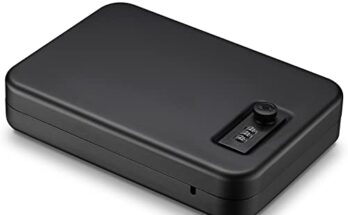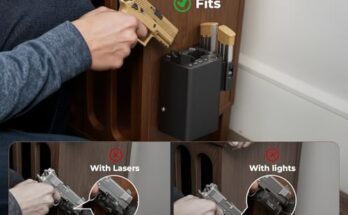Never put a gun safe in a garage or a basement prone to flooding. These locations can damage the safe and its contents.
Proper placement of a gun safe ensures both security and accessibility. Choosing the wrong spot can compromise the safety and integrity of your firearms. Garages often experience extreme temperature fluctuations and can be a target for burglars. Basements may seem secure but are vulnerable to water damage, which can ruin both the safe and its contents.
It’s essential to consider a dry, stable environment inside your home. Opt for places with minimal temperature changes and low humidity. Bedrooms or closets on the main floor are ideal. Ensuring your gun safe’s optimal location protects your investment and enhances safety.

Credit: m.youtube.com
Basement Risks
Storing a gun safe in the basement might seem like a good idea. It’s out of sight and usually has ample space. But basements come with their own set of risks that can compromise your firearms’ safety and longevity.
Moisture Issues
Basements are prone to moisture. Even a small amount of dampness can cause rust on your guns. Rust can damage the barrels, making them unsafe to use. Moisture can also damage the safe itself, leading to costly repairs or replacements.
To combat moisture, you can use a dehumidifier. But, this adds another layer of maintenance. And, it still might not solve the problem completely.
Flood Zones
If your basement is in a flood zone, avoid placing your gun safe there. Floodwaters can damage your firearms beyond repair. They can also destroy any important documents you might store in the safe.
Flood damage is often irreversible. It can result in the loss of valuable and irreplaceable items. Insurance might cover some losses, but the sentimental value is gone forever.
| Risk | Impact |
|---|---|
| Moisture | Rust on guns, damage to safe |
| Flood | Irreversible damage to guns and documents |
Consider these risks before placing a gun safe in your basement. It might seem convenient, but the potential problems outweigh the benefits.
Garage Concerns
Choosing the right spot for your gun safe is crucial. Many people think of the garage as a convenient location. But it can pose several challenges. Let’s dive into the garage concerns you should be aware of.
Temperature Fluctuations
Garages often face extreme temperature changes. This can be harmful to your guns. High heat can warp or damage the gun materials. Cold temperatures can make the metal parts brittle. Such conditions can also affect the safe’s locking mechanism. This could compromise your security.
Consider the humidity levels in your garage. Moisture can lead to rust and corrosion. This can damage both the safe and its contents. Investing in a dehumidifier may help, but it’s not a foolproof solution.
Easy Access For Thieves
Garages are often targeted by thieves. They are usually less secure than other parts of your home. A thief can easily break into a garage. It’s also easier to move a heavy safe out of a garage. This makes it a prime target.
Garages have multiple entry points. This increases the risk of unauthorized access. You may have a garage door, side door, and windows. Each point is a potential weak spot. Adding extra security measures can be costly and complex.
| Concern | Impact |
|---|---|
| Temperature Fluctuations | Damage to guns and safe |
| Easy Access for Thieves | Increased risk of theft |
- Temperature Fluctuations: Harmful to guns and safe
- Easy Access for Thieves: Higher theft risk
Bedrooms Pitfalls
Placing a gun safe in the bedroom might seem convenient. But this location has several drawbacks. Let’s explore the pitfalls of having a gun safe in the bedroom.
Privacy Invasion
Your bedroom is your private sanctuary. Installing a gun safe here can invite unnecessary attention. Family members or guests might notice it. This could lead to awkward questions or concerns about safety.
Consider how often people enter your bedroom. Whether it’s for cleaning or visiting, there’s always a risk of privacy invasion. This can be uncomfortable and disruptive.
Limited Space
Bedrooms often have limited space. This makes placing a large gun safe difficult. You might need to sacrifice essential furniture or storage areas.
Here is a table showing potential space issues:
| Item | Space Required |
|---|---|
| Queen Bed | 60 x 80 inches |
| Wardrobe | 24 x 60 inches |
| Gun Safe | Varies (often large) |
As you can see, fitting a gun safe can be challenging. It may create a cluttered environment, impacting your comfort.
Consider these points before choosing your bedroom as the location for your gun safe.
Living Room Hazards
Placing a gun safe in the living room can be risky. This area of your home has unique challenges. These challenges can compromise the safety and security of your firearms.
Visibility To Guests
A gun safe in the living room is often visible to guests. This visibility can attract unwanted attention. Visitors might notice the safe and become curious.
You want to keep the presence of firearms discreet. A safe in the living room makes this hard. It could lead to uncomfortable questions. Worse, it could attract potential burglars.
High Traffic Areas
The living room is a high traffic area. Many people walk through this space daily. This includes family members, friends, and visitors.
High traffic areas increase the risk of accidental bumps or knocks. These bumps can damage the safe or its contents. Constant movement around the safe can also wear down its exterior.
High traffic areas also make it harder to access the safe privately. You might need to open the safe when others are around. This can compromise the security of your firearms.
Closet Complications
Storing a gun safe in a closet seems logical. It’s hidden and secure. But this location can cause various problems. Below, we’ll explore the key issues.
Structural Weakness
Closets often have weak floors. They can’t support the weight of a heavy gun safe. This might cause the floor to sag or even collapse. Make sure to check the floor strength before placing a safe in the closet. A weak floor can lead to costly repairs and safety hazards.
Difficult Access
Closets are usually small and cramped. This makes it hard to access the safe quickly. During emergencies, every second counts. You need easy access to your safe. A cramped closet can slow you down. Consider the space around your safe for quick and easy access.

Credit: www.reddit.com
Attic Problems
Storing a gun safe in the attic may seem like a good idea. But it comes with several challenges. The attic can be one of the worst places for a gun safe. Here are some reasons why.
Poor Accessibility
Accessing the attic can be very difficult. Many attics have narrow staircases. This makes moving a heavy gun safe almost impossible.
Attics also have limited space. You might struggle to find a suitable spot for your gun safe. Limited space can lead to improper storage.
Retrieving a gun from an attic can be slow. In an emergency, you need quick access. The attic is not a good choice for this reason.
Fire Hazards
Attics are usually more prone to fire. They often contain insulation materials. These materials can catch fire easily.
Heat rises, making attics much hotter during a fire. This can damage your guns even if they are in a safe.
Attics are also harder for firefighters to reach. This increases the risk of total loss in case of fire.
| Problem | Impact |
|---|---|
| Poor Accessibility | Hard to move and retrieve guns quickly |
| Fire Hazards | Increased risk of damage and total loss |
- Attics can be hard to reach.
- They have limited space for a gun safe.
- Attics are more prone to fire.
- Firefighters may struggle to reach attics.
Given these issues, the attic is not a good place for a gun safe. Choose a location that is more accessible and safer.
Outdoor Locations
Placing a gun safe outdoors can seem like a good idea. It keeps firearms out of the house. However, outdoor locations come with many risks. Let’s explore why outdoor locations are not ideal.
Weather Exposure
Outdoor locations expose gun safes to weather elements. Rain, snow, and sun can damage the safe. Water can seep into the safe and cause rust. Rust can damage the guns inside.
Extreme temperatures can also affect the safe. Heat can warp the metal, making it easier to break into. Cold temperatures can cause the lock to freeze. You may not access your guns quickly in an emergency.
Consider using a table to understand the weather impacts better:
| Weather Condition | Potential Damage |
|---|---|
| Rain | Rust and water damage |
| Snow | Freezing locks and moisture issues |
| Sun | Warping and heat damage |
| Cold | Frozen locks and brittle metal |
Security Risks
Outdoor locations present higher security risks. Thieves can easily see and access the safe. A safe outside is an easy target.
Outdoor safes are often in isolated areas. This makes it easier for thieves to break in without being noticed. The sound of breaking into the safe may not alert anyone.
Critters and pests can also pose a threat. They can chew through parts of the safe and cause damage. This can lead to compromised security and damaged firearms.
Here are some security risks of placing a gun safe outdoors:
- Easy visibility to thieves
- Isolation from security measures
- Potential damage from pests
Near Heat Sources
Choosing the right location for your gun safe is crucial. One of the most important considerations is to avoid placing it near heat sources. Doing so can pose several risks that could harm your valuable items and compromise safety.
Fire Risks
Heat sources can significantly increase the risk of fire. Placing a gun safe near a furnace, stove, or heater is dangerous. In the event of a fire, the safe could be exposed to intense heat quickly. This exposure could lead to catastrophic results.
Heat-sensitive components within the gun safe might fail, rendering the safe useless. Fire can also damage the structural integrity of the safe. Its fire-resistant features may not work as intended. Therefore, it’s best to keep your gun safe away from any heat sources.
Damage To Contents
High temperatures can damage the contents inside the gun safe. Firearms and ammunition are particularly sensitive to heat. Exposure to high temperatures can cause ammunition to become unstable. Metal parts of firearms could warp or become brittle. These damages could make your firearms unsafe to use.
Electronic components within the safe, such as lock mechanisms, can also be compromised by heat. The heat can cause these components to fail, making it difficult or impossible to access the safe. To protect your valuable items, always place the gun safe in a cool, secure location.
| Heat Source | Risk |
|---|---|
| Furnace | High fire risk and structural damage to the safe |
| Stove | Increased temperature inside the safe, damaging contents |
| Heater | Potential failure of electronic components in the safe |
- Keep the safe in a cool, dry place.
- Avoid placing it near any heat sources.
- Ensure the location has good ventilation.

Credit: www.reddit.com
Frequently Asked Questions
Where Is The Best Place To Keep A Gun Safe In Your House?
The best place to keep a gun safe is in a secure, discreet location like a bedroom closet. Ensure it is out of children’s reach and away from potential burglars.
Should Gun Safes Be In Bedroom Or Garage?
Place gun safes in the bedroom for quick access during emergencies. Ensure it’s secured and out of children’s reach.
Can You Put A Gun Safe In A Closet?
Yes, you can put a gun safe in a closet. Ensure it fits securely and is bolted to the floor.
Where Can I Put A Gun Safe?
Place a gun safe in a secure, hidden location. Basements, closets, and bedrooms are ideal. Ensure it’s bolted down.
Conclusion
Choosing the right spot for your gun safe is crucial. Avoid placing it in the garage, basement, or easily accessible areas. Think about moisture, security, and accessibility. Proper placement ensures safety and longevity for your firearms. Make informed decisions to protect your valuables effectively.



